

Calligraphy Alphabet. Free Calligraphy Letters, Samples, Fonts in English, Cursive, Fancy, Gothic. How to create fake calligraphy. I have always loved beautiful calligraphy.
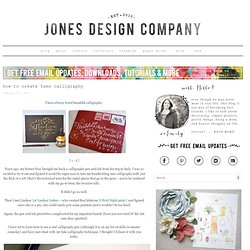
Years ago, my former boss brought me back a calligraphy pen and ink from her trip to Italy. I was so excited to try it out and figured it would be super easy to turn my handwriting into calligraphy with just the flick of a nib {that’s the technical term for the metal pieces that go in the pens – not to be confused with my go-to treat, the twizzler nib}. It didn’t go so well. Then I met Lindsay {of Lindsay Letters – who created that fabulous O Holy Night print } and figured since she is a pro, she could surely give some pointers and it wouldn’t be too hard. Again, the pen and ink proved too complicated for my impatient hands {have you ever tried it? I have yet to learn how to use a real calligraphy pen {although it is on my list of skills to master someday} and have just stuck with my fake calligraphy technique. First, choose a good fine tip ink pen. Now, write your letter. See how easy it is? Here’s another example. Then filled in the down strokes:
How to Learn Calligraphy. With its gorgeous lines and romantic appeal, there's no writing as lovely as calligraphy.
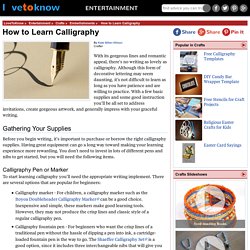
Although this form of decorative lettering may seem daunting, it's not difficult to learn as long as you have patience and are willing to practice. With a few basic supplies and some good instruction you'll be all set to address invitations, create gorgeous artwork, and generally impress with your graceful writing. Gathering Your Supplies Before you begin writing, it's important to purchase or borrow the right calligraphy supplies.
Having great equipment can go a long way toward making your learning experience more rewarding. Do It 101 Free Calligraphy Links Calligraphy Instruction and Projects. The principal tools for a calligrapher are the pen, which may be flat-balled or round-nibbed, and the brush.
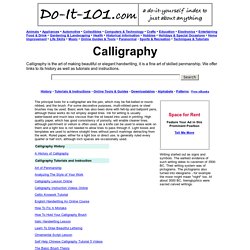
For some decorative purposes, multi-nibbed pens or steel brushes may be used. Basic work has also been done with felt-tip and ballpoint pens, although these works do not employ angled lines. Learn Calligraphy on Pinterest. The Beginner's Guide to Modern Calligraphy. Over the past few years, I have taught several beginners’ modern calligraphy workshops and answered countless calligraphy questions via email.
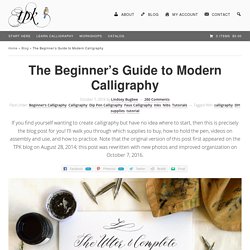
Those experiences have taught me that there is a need for a blog post like this one: a post that shows you where to start learning from scratch! In this blog post, I’ll walk you through how to learn modern calligraphy in a few simple steps. 1. Master Faux Calligraphy I believe that “faux calligraphy” — modern calligraphy created with a standard (ballpoint, gel, etc.) pen — is the best introduction to dip pen calligraphy. A standard pen is approachable and non-intimidating. Every TPK printable calligraphy worksheet starts with a faux calligraphy section. 2. You can find a detailed starter kit guide in The Ultimate Modern Calligraphy Starter Kit post, but here’s a basic summary and links to what you need: 2 Nikko G nibs – You can read about why I think this nib is the best beginner nib in this blog post. 3. 4.
Calligraphy Lessons for Beginners. How To Learn The Art of Calligraphy Calligraphy is a beautiful art which adds class and elegance to all kinds of stationery, and is especially popular for using on wedding invitations for an extra special touch.
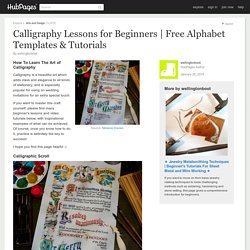
If you want to master this craft yourself, please find many beginner's lessons and video tutorials below, with inspirational examples of what can be achieved. Calligraphyforbeginners. Calligraphy Pen Basics. There are two types of pens you can choose from: the traditional dip pen, or a regular cartridge-filled pen.
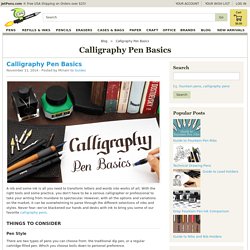
Which you choose boils down to personal preference. Using a dip pen allows for more freedom in choosing nibs, inks, and even holders, though they tend to be messy and more temperamental. When choosing holders, you can use straight holders that act as regular pens, or oblique holders, which some calligraphers prefer for more versatility in writing angles. Many left-handed calligraphers also use oblique holders to hold the pen more naturally without disturbing their work.
Dip pen. Cartridge-filled pen. On the other hand, using a cartridge-filled pen is much cleaner and more convenient especially if you don't want to lug a bunch of tools around. Getting Back to Basics. Happy Friday!
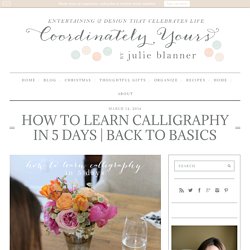
You know what that means – it’s time to learn calligraphy! Today, we’re getting back to basics. When you first learned how to write in elementary school, you used lined paper & started with basic strokes. The same applies when learning calligraphy. Today, we’re going to get used to the feeling of writing with the pen, learn how to apply the pressure that results in beautiful strokes, & practice, practice, practice! Calligraphic Fonts. Script > Calligraphy fonts. Calligraphy Fonts. 360 Free Calligraphy Fonts. How To Start Writing Calligraphy.